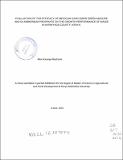| dc.description.abstract | Crop fertilization has been a great challenge in Kenya, especially to the small scale farmers. The great challenge has been on financial implications due to the use of mineral fertilizer. Small scale farmers cannot cope with the high and ever increasing prices of mineral fertilizers. Due to their cost, mineral fertilizer has never been friendly to the farmers. Despite the high prices in the market, there is high exploitation of farmers by traders as they sell in retail in the rural areas. This makes their prices to go up unreasonably for many farmers to afford. Mineral fertilizers may also have adverse effect to the environment as well as soil fertility as the elements they contain may rise in the soil to levels that can be toxic to crops. The result is continuous low crop yields resulting to shortage of food in the country which leads to food insecurity. A cheaper way of the use of green manure is a practice which is sustainable and helps to maintain plant nutrients in the soil. An experiment consisting of 12 treatments arranged in randomized complete block design (RCBD) with 3 replications for each treatment was set up in Kirinyaga County to evaluate the efficacy of fresh Mexican Sunflower green manure and di-ammonium phosphate in the production of maize. Individual plots 3 x 3 m with an inter plot spacing of 50 cm and inter block spacing of 100 cm were used. Both di-ammonium phosphate fertilizer and Mexican sunflower treatments were applied one week before planting. The growth performance for maize was observed and data collected on plant height, stem diameter, cob length. Above ground biomass, 100 seed weight and yields. Harvest index (HI) was also calculated. The data was recorded and analyzed. The result showed that the growth performance of maize when tithonia biomass was used was as good as when inorganic fertilizer was used. The result further showed that, the growth performance for maize increased with increase in the amount of tithonia as it was for di-ammonium phosphate. | en_US |

